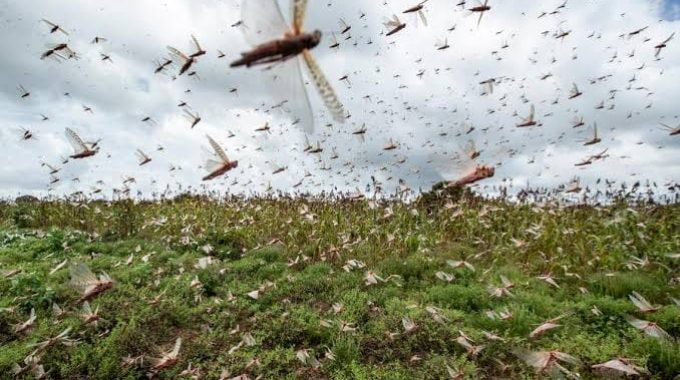Locust swarms are by far one of the deadliest pests known for greedily feeding on agricultural crops, trees, and other plants.
These pests devastate crops and grasses grown for people and livestock, causing famine and starvation in communities that depend on their crops for survival.
Originating at the India-Pakistan border, the locusts migrated into Somalia and Ethiopia destroying nearly 71,000 hectares of farmland in the two countries.
The deadly pests were first spotted in Kenya, Somalia, and Ethiopia in December 2019 and have since ravaged thousands of hectares of farmland making it the worst locust invasion in 70 years.
According to the food and agricultural organization (FAO), the current situation remains extremely alarming in three main areas.
Reports from FAO indicate that Locust plagues occur intermittently in the Horn of Africa, but this invasion is the worst in 25 years.
Locusts can cover from 100 to 200 kilometers in a day and will fly at the speed of the wind, moving up to about 2,000 meters above sea level.

They feed on leaves, shoots, flowers, fruit, seeds, stems and bark and eat many types of food both crops and noncrop plants including maize, millet, rice, barley, sugarcane, sorghum, cotton, weeds and vegetables, fruits like bananas dates among others.
One swarm can cover up to 1200 square kilometers and can contain between 40 and 80 million locusts per square kilometer approximately 50 to 100 billion locusts per swarm.
Farmers locally scare off these pests by making noise and burning tires but this doesn’t solve shifts the problem to neighboring farms, and locust swarms can easily return to reinfest previously visited fields.
The Ugandan government has listed three chemicals to use in the spray against the desert locusts. They include Fenitrothion a phosphorothioate insecticide, Malathion which is an organophosphate insecticide and Pyrethroid insecticides.
Stephen Tibeijuka Byantwale, the Commissioner of Crop Protection at the Ministry of Agriculture, Animal Industry and Fisheries, says the government has been preparing for these locusts and the chemicals being applied are less harmful to human life since they have been used over time.
The government has also deployed 2,000 Uganda People’s Defense Forces (UPDF) officers who have been undergoing training from Aswa – Lolium to handle the invasion.
The government has paid approximately 11 billion Uganda Shillings, as a country’s contribution towards Desert Locust Control Organisation for Eastern Africa (DLCO-EA).
DLCO-EA is a regional pest and vector management organization established by an International Convention signed in Addis Abeba, Ethiopia in 1962.
Its mandate is to promote control operations and forecast techniques against upsurges and plagues of the desert locust.
Uganda is among the nine countries that form the body that including; Kenya, Tanzania, Ethiopia, Sudan, South Sudan, Eritrea, Somalia, and Djibouti.















